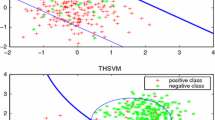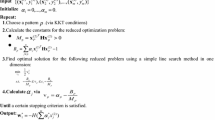Abstract
Twin-hypersphere support vector machine (THSVM) for binary pattern recognition aims at generating two hyperspheres in the feature space such that each hypersphere contains as many as possible samples in one class and is as far as possible from the other one. THSVM has a fast learning speed since it solves two small sized support vector machine (SVM)-type quadratic programming problems (QPPs). However, it only simply considers the prior class-based structural information in the optimization problems. In this paper, a structural information-based THSVM (STHSVM) classifier for binary classification is presented. This proposed STHSVM focuses on the cluster-based structural information of the corresponding class in each optimization problem, which is vital for designing a good classifier in different real-world problems. In addition, it also leads to a fast learning speed since this STHSVM solves a series of smaller-sized QPPs compared with THSVM. Experimental results demonstrate that STHSVM is superior in generalization performance to other classifiers.




Similar content being viewed by others
Notes
Available at: http://www.mathworks.com.
References
Boser B, Guyon L, Vapnik VN (1992) A training algorithm for optimal margin classifiers. In: Proceedings of the 5th Annual Workshop on Computational Learning Theory, ACM Press, Pittsburgh, 1992, pp 144–152
Vapnik VN (1995) The natural of statistical learning theory. Springer, New York
Vapnik VN (1998) Statistical learning theory. Wiley, New York
He Q, Wu C (2011) Separating theorem of samples in Banach space for support vector machine learning. Int J Mach Learn Cybernet 2(1):49–54
Wang X, He Q, Chen D, Yeung D (2005) A genetic algorithm for solving the inverse problem of support vector machines. Neurocomputing 68:225–238
Wang X, Lu S, Zhai J (2008) Fast fuzzy multi-category SVM based on support vector domain description. Int J Pattern Recognit Artif Intell 22(1):109–120
Osuna E, Freund R, Girosi F (1997) Training support vector machines: an application to face detection. In: Proceedings of IEEE Computer Vision and Pattern Recognition, San Juan, Puerto Rico, 1997, pp 130–136
El-Naqa I, Yang Y, Wernik M, Galatsanos NP, Nishikawa RM (2002) A support vector machine approach for detection of microclassification. IEEE Trans Med Imaging 21(12):1552–1563
Schölkopf B, Tsuda K, Vert J-P (2004) Kernel methods in computational biology. MIT Press, Cambridge
Jayadeva, Khemchandani R, Chandra S (2007) Twin support vector machines for pattern classification. IEEE Trans Pattern Anal Mach Intell 29(5):905–910
Kumar MA, Gopal M (2009) Least squares twin support vector machines for pattern classification. Expert Syst Appl 36(4):7535–7543
Ghorai S, Mukherjee A, Dutta PK (2009) Nonparallel plane proximal classifier. Signal Process 89(4):510–522
Peng X (2010) A \(\nu\)-twin support vector machine (\(\nu\)-TSVM) classifier and its geometric algorithms. Inform Sci 180(15):3863–3875
Peng X (2011) TPMSVM: a novel twin parametric-margin support vector machine for pattern recognition. Pattern Recognit 44(10–11):2678–2692
Chen X, Yang J, Ye Q, Liang J (2011) Recursive projection twin support vector machine via within-class variance minimization. Pattern Recognit 44(10–11):2643–2655
Shao YH, Chen WJ, Deng NY (2014) Nonparallel hyperplane support vector machine for binary classification problems. Inform Sci 263:22–35
Peng X (2010) TSVR: an efficient twin support vector machine for regression. Neural Netw 23(3):365–372
Peng X (2012) Efficient twin parametric insensitive support vector regression model. Neurocomputing 79:26–38
Peng X, Xu D (2013) A twin-hypersphere support vector machine classifier and the fast learning algorithm. Inform Sci 221(1):12–27
Yeung D, Wang D, Ng W, Tsang E, Zhao X (2007) Structured large margin machines: sensitive to data distributions. Mach Learn 68(2):171–200
Belkin M, Niyogi P, Sindhwani V (2004) Manifold regularization: a geometric framework for learning from examples, Dept. Comput. Sci., Univ. Chicago, Chicago, IL, Techique report, TR-2004-06, Aug 2004
Chen WJ, Shao YH, Hong N (2014) Laplacian smooth twin support vector machine for semi-supervised classification. Int J Mach Learn Cybernet 5(3):459–468
Rigollet P (2007) Generalization error bounds in semi-supervised classification under the cluster assumption. J Mach Learn Res 8:1369–1392
Shivaswamy PK, Jebara T (2007) Ellipsoidal kernel machines. In: Proceeding of 12th International Workshop on Artificial Intelligence Statistic, 2007, pp 1–8
Lanckriet GRG, Ghaoui LE, Bhattacharyya C, Jordan MI (2002) A robust minimax approach to classfication. J Mach Learn Res 3:555–582
Huang K, Yang H, King I, Lyu MR (2008) Maxi–min margin machine-learning large margin classifiers locally and globally. IEEE Trans Neural Netw 19:260–272
Xue H, Chen S, Yang Q (2011) Structural regularized support vector machine: a framework for structural large margin classifier. IEEE Trans Neural Netw 22:573–587
Peng X, Xu D (2014) Structural regularized projection twin support vector machine for data classification. Inform Sci 279:416–432
Hartigan JA, Wong MA (1979) A \(k\)-means clustering algorithm. Appl Stat 28(1):100–108
Lu S-Y, Fu KS (1978) A sentence-to-sentence clustering procedure for pattern analysis. IEEE Trans Syst Man Cybernet 8(5):381–389
Zadeh LA (1965) Fuzzy sets. Inform Control 8:338–353
Ward JH (1963) Hierarchical grouping to optimize an objective function. J Am Stat Assoc 58(301):236–244
Salvador S, Chan P (2004) Determining the number of clusters/segments in hierarchical clustering/segmentation algorithms. In: Proc. 16th IEEE Int. Conf. Tools Artif. Intell., Nov 2004, pp 576584
Rätsch G (2000) Benchmark repository, datasets available at http://ida.first.fhg.de/projects/bench/benchmarks.htm
Acknowledgments
The authors would like to genuinely thank the anonymous reviewers for their constructive comments and suggestions. This work is partly supported by the National Natural Science Foundation of China (61202156), the National Natural Science Foundation of Shanghai (12ZR1447100), and the program of Shanghai Normal University (DZL121).
Author information
Authors and Affiliations
Corresponding author
Electronic supplementary material
Below is the link to the electronic supplementary material.
Rights and permissions
About this article
Cite this article
Peng, X., Kong, L. & Chen, D. A structural information-based twin-hypersphere support vector machine classifier. Int. J. Mach. Learn. & Cyber. 8, 295–308 (2017). https://doi.org/10.1007/s13042-014-0323-4
Received:
Accepted:
Published:
Issue Date:
DOI: https://doi.org/10.1007/s13042-014-0323-4




